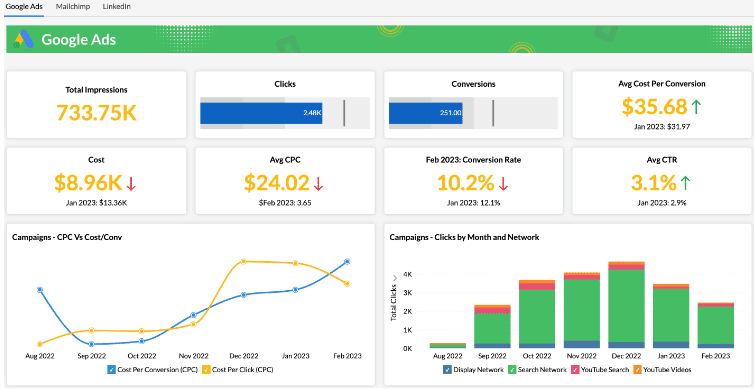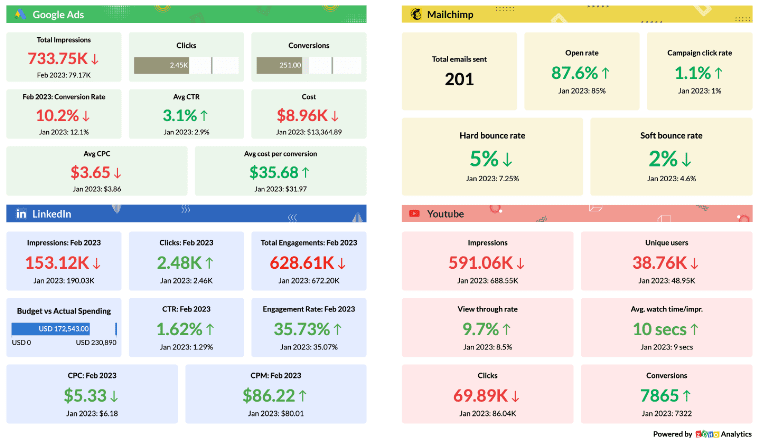As a business, finding the most effective way to reach your target audience and convert leads into customers is crucial. Outbound marketing, a traditional method that involves reaching out to potential customers through various channels, remains a valuable strategy for many businesses. With the right analytics, you can optimize your outbound marketing campaigns and significantly improve your return on investment (ROI). In this article, we'll delve into the world of outbound marketing analytics, discuss its importance, and share insights to help you maximize your campaign results.
As a business, finding the most effective way to reach your target audience and convert leads into customers is crucial. Outbound marketing, a traditional method that involves reaching out to potential customers through various channels, remains a valuable strategy for many businesses. With the right analytics, you can optimize your outbound marketing campaigns and significantly improve your return on investment (ROI). In this article, we'll delve into the world of outbound marketing analytics, discuss its importance, and share insights to help you maximize your campaign results.
Understanding Outbound Marketing Analytics
Understanding Outbound Marketing Analytics
Outbound marketing analytics is the process of measuring, analyzing, and optimizing the performance of your outbound marketing efforts. By tracking essential metrics, you can identify areas of improvement, allocate resources effectively, and ultimately drive better results for your business. Some of the most critical outbound marketing channels include email marketing, telemarketing, direct mail, TV and radio ads, and trade shows.
The Importance of Analytics in Outbound Marketing
The Importance of Analytics in Outbound Marketing
In today's competitive market, using analytics to optimize your outbound marketing campaigns is not just a luxury—it's a necessity. Here are some reasons why analyzing your outbound marketing efforts is crucial:
Identify Opportunities for Improvement: By evaluating the performance of your campaigns, you can uncover areas where changes can be made to boost overall effectiveness.
Allocate Resources Efficiently: Analytics allows you to prioritize high-performing channels and shift resources to areas with the most significant potential for ROI.
Measure Success: Quantifying the success of your campaigns enables you to assess your marketing strategies' effectiveness and adjust them as needed.
Understand Your Target Audience: Through data analysis, you can gain valuable insights into your audience's preferences, allowing you to tailor your approach and deliver more personalized experiences.
Key Metrics to Monitor in Outbound Marketing Analytics
Key Metrics to Monitor in Outbound Marketing Analytics
To maximize your outbound marketing efforts' potential, keep a close eye on the following metrics:
Response Rates: Track the percentage of your target audience who respond to your marketing messages, whether it's opening an email, clicking on an ad, or engaging with a social media post.
Conversion Rates: Monitor the percentage of leads who take a desired action, such as making a purchase or signing up for a newsletter.
Cost per Lead (CPL): Calculate the average cost of acquiring a new lead through your outbound marketing efforts.
Cost per Acquisition (CPA): Determine the average cost of converting a lead into a paying customer.
Return on Investment (ROI): Measure the overall profitability of your outbound marketing campaigns by comparing the revenue generated to the total cost.
Tips for Optimizing Your Outbound Marketing Analytics
Tips for Optimizing Your Outbound Marketing Analytics
To harness the power of outbound marketing analytics and enhance your campaigns, consider the following tips:
Segment Your Audience: Break your target audience into smaller groups based on specific characteristics, such as demographics or interests, and tailor your marketing messages accordingly.
Test and Refine: Regularly conduct A/B testing to compare different marketing elements, such as headlines or visuals, and use the results to refine your campaigns for better performance.
Leverage Technology: Utilize advanced analytics tools and software to collect, analyze, and visualize data, making it easier to identify trends and opportunities.
Monitor Competitors: Keep an eye on your competitors' outbound marketing strategies and learn from their successes and failures.
Collaborate with Other Departments: Work closely with your sales, customer service, and product development teams to align your outbound marketing strategies with overall business objectives.
Aligning Outbound Marketing with Inbound Strategies
Aligning Outbound Marketing with Inbound Strategies
To achieve the best results, consider integrating your outbound marketing analytics with inbound marketing efforts. This combination creates a cohesive and comprehensive marketing strategy that maximizes your chances of reaching and engaging your target audience. Inbound marketing, which focuses on attracting customers through valuable content and tailored experiences, can complement your outbound campaigns and improve overall effectiveness. Here's how:
Utilize Data from Both Strategies: Combine insights gathered from both inbound and outbound marketing analytics to create a more accurate picture of your target audience and their preferences.
Create Seamless Experiences: Use outbound marketing to drive traffic to your inbound marketing assets, such as blog posts or downloadable content, and create a smooth transition for your audience.
Improve Retention and Loyalty: By providing valuable content and nurturing relationships through inbound marketing, you can increase customer retention and loyalty, further enhancing the results of your outbound efforts.
Optimize Across Channels: Analyze performance data from all marketing channels, both outbound and inbound, to identify the most effective strategies and optimize your overall marketing mix.
Implementing Outbound Marketing Analytics in Your Organization
Implementing Outbound Marketing Analytics in Your Organization
To successfully integrate outbound marketing analytics into your business, follow these steps:
Establish Clear Objectives: Define your marketing goals and determine the key performance indicators (KPIs) you will use to measure success.
Choose the Right Tools: Select analytics tools and software that meet your organization's needs and provide the necessary features to track, analyze, and visualize your data.
Collect and Analyze Data: Implement data collection methods across your outbound marketing channels, and regularly analyze the information to identify trends, opportunities, and areas for improvement.
Take Action Based on Insights: Use the insights gained from your analytics to make data-driven decisions, optimize your marketing campaigns, and allocate resources effectively.
Continuously Improve: Monitor your outbound marketing analytics consistently and adjust your strategies as needed to stay ahead of the competition and achieve your goals.
Outbound marketing analytics with Zoho Analytics
Outbound marketing analytics with Zoho Analytics
While each marketing tool used for outbound activities provides campaign-specific data, marketers require assistance in gaining a clear and overall understanding. Analyzing all of the data will take a long time, and manually importing the data is impossible.
You can use Zoho Analytics to automatically import all of your outbound data from the marketing tools you use and blend it to analyze the overall performance of the tools. To simplify data analysis, Zoho Analytics includes critical features such as data blending, multiple data visualization options, and augmented analysis using artificial intelligence and machine learning.
You can use Zoho Analytics to create a comprehensive outbound marketing dashboard. With standard and custom metrics, you'll get a clear picture of your outbound activity performance, understand which channel works best for you, optimize your strategies, and improve performance.
Outbound marketing dashboards
Outbound marketing dashboards
The primary goal of a dashboard is to analyze all relevant data in one place, saving you time and effort. Whatever paid acquisition channels you use, you can connect the marketing tools you use or simply import the data at your disposal. Following a successful connection, Zoho Analytics will automatically generate 100+ relevant reports and dashboards based on your data. You can also use your data to generate a plethora of reports and dashboards.
When you've synced all of your data and created the necessary visualizations, it's only a matter of time before you can start extracting insights. Discover trends and patterns in these reports to determine the performance of your campaign and create key performance indicator (KPI) widgets to track key metrics. Here's an example of an outbound marketing dashboard we designed. Google Ads for paid searches, LinkedIn for social media ads, and Mailchimp for cold emails were all linked.

(Click here to view an interactive version of this dashboard)
This dashboard provides an overview of your outbound activity performance without requiring you to switch between apps. You only need to review the dashboard from time to time to track the performance of your campaigns across various marketing platforms.
This dashboard will allow you to determine which marketing channel is performing the best based on conversion rates, ROI percentages, and engagement. You can also optimize your strategies by analyzing each marketing channel separately.
Outbound marketing KPI dashboard as a bonus
Outbound marketing KPI dashboard as a bonus
You should track the performance of paid acquisition channels in real time because they require cost per impression and cost per click. When you're on the go, however, it's impossible to track every metric available. To stay current, you can use a KPI dashboard to track only the most important metrics.
You can access the key metrics you need to stay informed by creating a KPI dashboard for outbound marketing. Here's an example of an outbound marketing KPI dashboard with key metrics.

(Click here to view an interactive version of this dashboard)
This dashboard is intended to provide quick access to key metrics for all paid marketing channels. You can monitor this dashboard at predetermined intervals. If you require additional information or notice a critical data change, click the More button to return to the main dashboard. From there, you can thoroughly analyze performance and optimize it for better results.
Conclusion: Maximize ROI with Outbound Marketing Analytics
Conclusion: Maximize ROI with Outbound Marketing Analytics
Outbound marketing analytics is an essential component of any successful marketing strategy. By monitoring key metrics, identifying opportunities for improvement, and making data-driven decisions, you can optimize your outbound campaigns and maximize your return on investment. Don't underestimate the power of analytics—embrace it to propel your business to new heights.
Sign up for a 15-day free trial of Zoho Analytics, connect your marketing tools, and begin gaining insights. Registering and integrating your business apps takes only a few clicks.
Frequently Asked Questions
What is the meaning of outbound marketing?
Outbound marketing refers to traditional marketing techniques that involve reaching out to potential customers through various channels, such as email marketing, telemarketing, direct mail, TV and radio ads, and trade shows. The goal is to promote products or services and generate leads or sales.
What technique is used in outbound marketing?
Outbound marketing techniques include email marketing, telemarketing, direct mail, TV and radio advertising, print advertising, trade shows, and cold calling. These techniques involve pushing marketing messages to a broad audience, often through interruption-based methods, in hopes of generating leads and sales.
What is inbound and outbound in analytics?
Inbound and outbound analytics refer to measuring, analyzing, and optimizing the performance of inbound and outbound marketing strategies. Inbound marketing focuses on attracting customers through valuable content and tailored experiences, while outbound marketing involves reaching out to potential customers through various channels. Analytics helps businesses evaluate the effectiveness of these strategies and make data-driven decisions to improve marketing efforts.
How does outbound marketing work?
Outbound marketing works by sending promotional messages to a broad audience through various channels, such as email, telemarketing, direct mail, and advertising. The goal is to raise brand awareness, generate leads, and ultimately drive sales. Businesses measure the success of outbound marketing efforts by tracking key metrics, such as response rates, conversion rates, and ROI.
Is SEO an outbound marketing?
SEO (Search Engine Optimization) is not considered outbound marketing; it falls under the umbrella of inbound marketing. SEO involves optimizing website content, structure, and performance to improve visibility on search engines, attracting potential customers to your website organically rather than through interruption-based methods.
